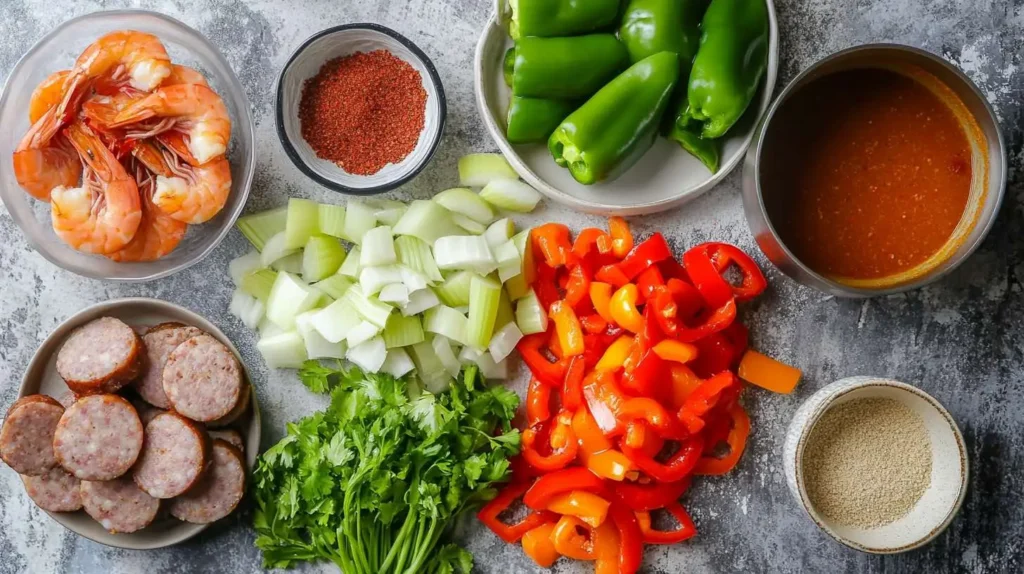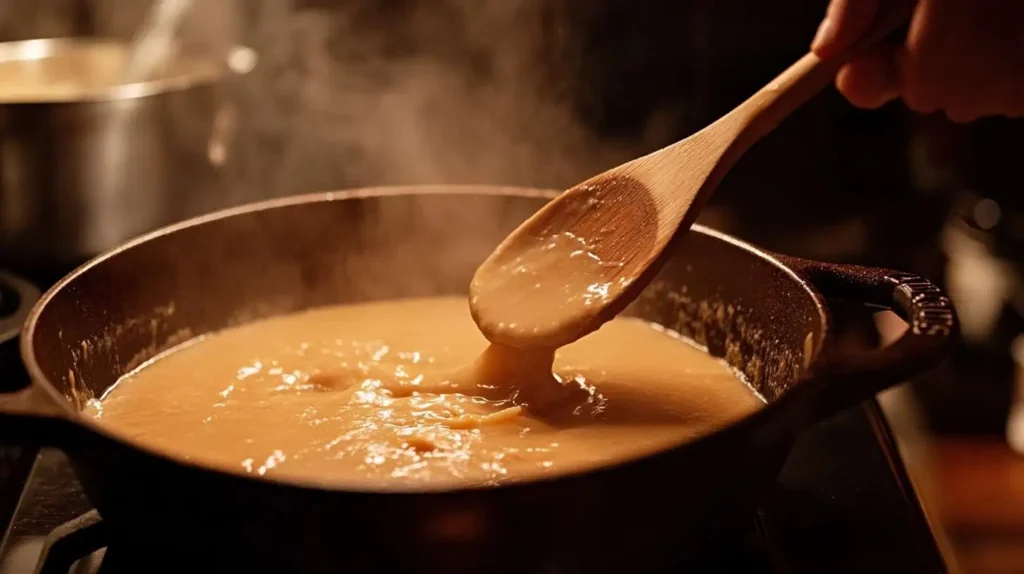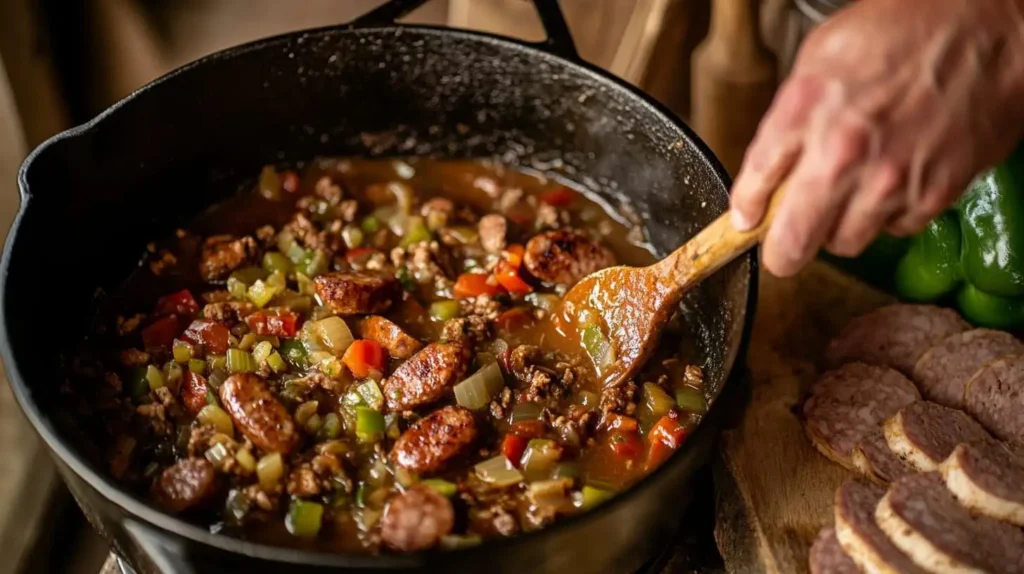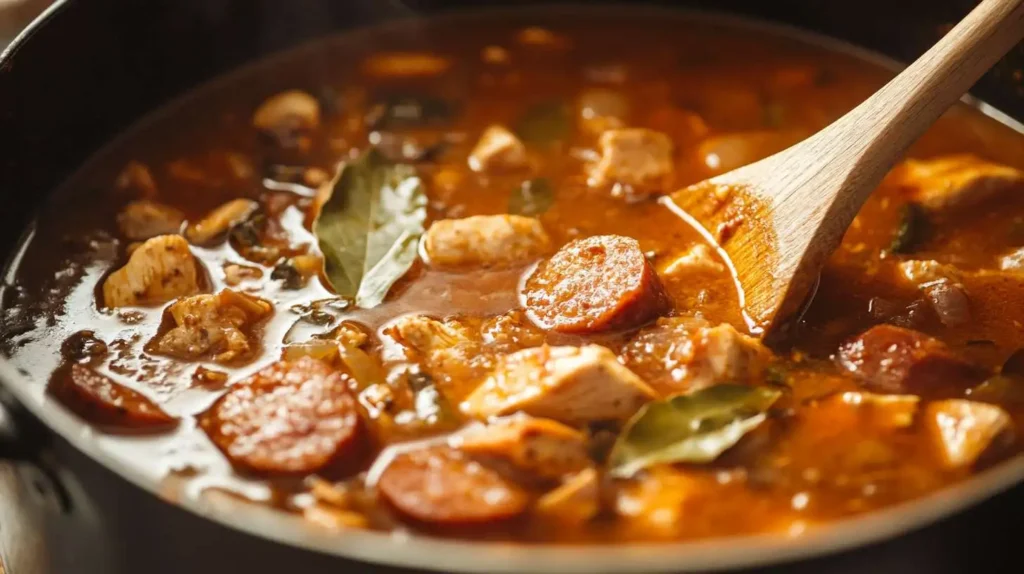There’s something magical about a simmering pot of Louisiana Gumbo Recipe. The aroma of smoky sausage, tender shrimp, and rich, dark roux fills the air, carrying with it the stories of generations. In Louisiana, gumbo isn’t just food—it’s tradition, a dish that brings people together, whether at a Sunday family gathering or a bustling Mardi Gras celebration. Every spoonful tells a story of the state’s diverse history, blending African, French, Spanish, and Native American influences into one perfect bowl of comfort.
I remember my first taste of real Louisiana gumbo at my grandmother’s kitchen table. The steam rose as she ladled it over fluffy white rice, her voice soft but certain: “A good gumbo takes time, cher.” She had spent hours stirring that roux to a deep, chocolate brown, her patience as rich as the flavors she coaxed from the pot. That first bite was everything—warm, bold, and soulful. And now, it’s my turn to pass on the recipe, just like she did.
Table of contents
Key Ingredients for the Perfect Louisiana Gumbo Recipe

A great gumbo starts with the right ingredients, each playing a crucial role in building layers of flavor. From the smoky depth of Andouille sausage to the rich, velvety roux, every element matters. Let’s break down the must-have ingredients for an authentic Louisiana gumbo.
1. The Holy Trinity: The Flavor Foundation
In Louisiana cooking, the Holy Trinity refers to a simple yet powerful combination of onion, celery, and bell pepper. Much like mirepoix in French cuisine, this trio serves as the backbone of gumbo, adding a savory depth that enhances every bite.
2. The Roux: The Secret to Richness
A proper roux (a mixture of flour and fat) is what gives gumbo its signature color and thickness. Cooked low and slow, roux can range from light brown to deep chocolate, with each shade influencing the gumbo’s final flavor. The darker the roux, the richer and more complex the taste.
3. Proteins: Chicken, Sausage, and Seafood Options
Gumbo can be customized with various proteins:
- Chicken & Sausage Gumbo – A classic, often made with Andouille sausage, a smoky, spicy pork sausage that enhances the broth.
- Seafood Gumbo – Features shrimp, crab, oysters, or crawfish, creating a lighter, brinier version of the dish. If you’re a seafood lover, you might also enjoy this flavorful Snow Crab Legs Recipe, a perfect side dish to complement your gumbo feast.
- Combination Gumbo – The best of both worlds, mixing chicken, sausage, and seafood for a hearty feast.
4. Gumbo Spices and Seasonings
Louisiana gumbo wouldn’t be the same without its signature spice blend. The essential seasonings include:
- Cajun or Creole seasoning (a mix of paprika, garlic powder, onion powder, and cayenne)
- Bay leaves for a subtle herbal touch
- Thyme & oregano for earthiness
- Filé powder (ground sassafras leaves) for a traditional thickening agent and a unique flavor boost
5. Stock or Broth: The Flavorful Base
A rich, homemade stock is what truly elevates gumbo. Whether using chicken stock for a meat-based gumbo or seafood stock for a seafood gumbo, the broth carries all the seasonings and ties everything together.
6. Okra or Filé Powder: Traditional Thickeners
Some gumbo recipes rely on okra for its natural thickening properties, while others use filé powder (added at the end of cooking). Some cooks use both, while others stick to one—either way, they contribute to gumbo’s signature texture.
How to Make Authentic Louisiana Gumbo Recipe (Step-by-Step Guide)
Making gumbo is a labor of love, requiring patience and care. But the result? A soul-warming dish that’s worth every minute. Follow these steps to create an authentic Louisiana gumbo.
Step 1: Preparing the Roux

- Heat ½ cup of vegetable oil in a large pot over medium heat.
- Slowly whisk in ½ cup of all-purpose flour, stirring constantly.
- Keep stirring for 20-30 minutes, allowing the roux to darken from blonde to a rich, dark brown (similar to melted chocolate). Be patient—this step defines the depth of your gumbo’s flavor.
Step 2: Cooking the Holy Trinity & Adding the Proteins

- Once the roux reaches the right color, immediately add the diced onion, celery, and bell pepper. Stir well to coat in the roux.
- Cook for about 5 minutes until softened.
- Add sliced Andouille sausage and chicken pieces (if using). Brown them slightly to develop more flavor.
Step 3: Simmering the Gumbo for Maximum Flavor

- Pour in 6 cups of stock (chicken or seafood, depending on your gumbo type).
- Add 2 bay leaves, 1 teaspoon of thyme, 1 teaspoon of Cajun seasoning, and salt and pepper to taste.
- Bring to a boil, then reduce to a low simmer. Cover and let cook for 45 minutes to an hour, stirring occasionally.
Step 4: Adding the Seafood (if using)
- If making a seafood gumbo, add shrimp, crab, or crawfish in the last 10 minutes of cooking to prevent overcooking.
- If using okra, add it at this stage to help thicken the gumbo.
Step 5: Final Touches & Serving
- Turn off the heat and sprinkle in filé powder for an extra depth of flavor.
- Let the gumbo rest for 10 minutes before serving.
- Serve over a bowl of steamed white rice, garnished with chopped green onions and fresh parsley.
Enjoy your homemade Louisiana gumbo—rich, hearty, and bursting with Southern flavor! 🍲
Common Mistakes to Avoid When Cooking Louisiana Gumbo Recipe
Even seasoned cooks can run into trouble when making gumbo. To ensure your dish turns out rich and flavorful, here are some common mistakes to avoid:
1. Rushing the Roux
The roux is the foundation of gumbo, and rushing it can lead to disaster. A properly cooked roux takes at least 20-30 minutes of constant stirring to achieve that deep, chocolate-brown color. Burnt roux? You’ll have to start over—there’s no saving it!
2. Overcrowding with Too Many Ingredients
It’s tempting to throw in everything, but gumbo is about balance. Too many proteins or vegetables can overwhelm the dish, making it muddled rather than harmonious. Stick to a well-thought-out combination—either chicken and sausage or seafood, or a mix of both.
3. Adding Seafood Too Early
Shrimp, crab, and crawfish cook quickly. If you add them at the beginning, they’ll turn rubbery. Instead, add seafood in the last 10 minutes of cooking to keep it tender and juicy.
Variations of Louisiana Gumbo Recipe
Gumbo is a dish that has evolved over centuries, with different regions and families putting their own spin on it. Here are the main variations:
1. Cajun Gumbo vs. Creole Gumbo
- Cajun Gumbo: Uses a dark roux, no tomatoes, and typically features chicken and sausage. It’s rustic and hearty.
- Creole Gumbo: Often contains tomatoes, is a bit lighter, and usually includes seafood (shrimp, crab, and oysters).
2. Seafood Gumbo
A coastal Louisiana favorite, this gumbo focuses on shrimp, crab, oysters, and sometimes crawfish. The broth is usually made with a seafood stock, giving it a briny depth. If you enjoy seafood, try this easy Fishcakes and Scallops Stir-Fry Recipe, another great way to savor fresh seafood flavors.
3. Chicken and Sausage Gumbo
This is the most common gumbo in home kitchens across Louisiana. It’s made with Andouille sausage, chicken, a dark roux, and rich spices for a deep, smoky flavor.
4. Vegetarian Gumbo (Gumbo Z’Herbes)
A unique twist, this gumbo is made with a mix of leafy greens (collard, mustard, turnip greens) and thickened with a roux. Traditionally, it was served on Good Friday when meat was avoided.
Final thoughts about Louisiana Gumbo Recipe
Gumbo is more than just a dish—it’s a reflection of Louisiana’s rich cultural history and a celebration of bold, comforting flavors (If you enjoy bold flavors and Cajun-inspired dishes, you might love this quick and satisfying Buffalo Chicken Wrap Recipe, perfect for a casual meal.) . Whether you prefer a smoky Cajun-style chicken and sausage gumbo or a savory Creole seafood version, the key to perfect gumbo is patience, good ingredients, and a well-crafted roux.
Now that you have the secrets to making authentic Louisiana gumbo, it’s time to grab a pot, stir up a roux, and bring a little taste of the South to your kitchen. And remember—like any great gumbo, the best recipes come with a story, so make sure to pass yours down for generations to come!
FAQs About Louisiana Gumbo Recipe
Gumbo is a stew served over rice, while jambalaya is a one-pot rice dish where the rice is cooked with the other ingredients.
You can use a dark roux, okra, or filé powder. Okra should be added during cooking, while filé powder is sprinkled in after removing from heat.
Absolutely! Gumbo tastes even better the next day as the flavors deepen. Store it in the fridge for up to 3 days or freeze for up to 3 months.
Yes! If you’re avoiding flour, use okra or filé powder for thickening. Some low-carb versions use xanthan gum instead.

